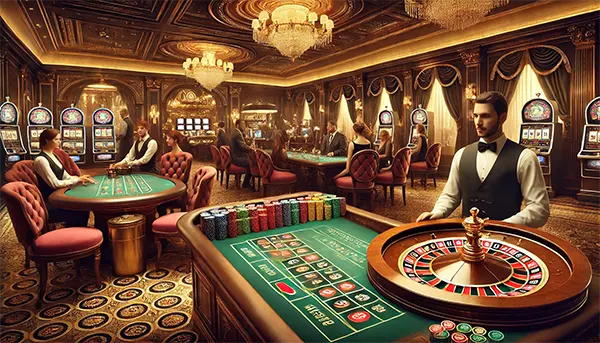
The Mathematics of Games: How Casinos Establish the House Edge?
Casinos always maintain a mathematical edge over players, ensuring long-term profitability. This phenomenon, known as the house edge, is based on strict statistical and probabilistic laws embedded in the rules of each game. Every wager placed by a player contributes to this advantage, which is designed to ensure that, in the long run, the casino remains profitable. Many players mistakenly believe that they can beat the system with lucky streaks or betting strategies, but the underlying mathematics ensures the house’s advantage over time.
Understanding the mechanics of the house edge is crucial for any gambler, as it allows for informed decision-making when choosing which games to play. While some games offer lower house edges than others, all casino games are ultimately designed to favour the house. However, this does not mean that players cannot win; it simply means that the odds are structured in such a way that the casino will always come out ahead over a large number of bets.
What Is the House Edge?
The house edge is the percentage of each bet that the casino expects to keep as profit over time. This is the fundamental principle that allows gambling establishments to remain profitable. Unlike players who seek short-term wins, casinos operate on a long-term strategy where probability and statistics are always in their favour.
For example, in a game like roulette, the house edge is built into the wheel itself. In European roulette, the single green zero gives the house an edge of 2.7%, while in American roulette, the additional double zero increases the house edge to 5.26%. These percentages ensure that, even if a player wins in the short term, the casino will ultimately profit from the game in the long run.
The house edge is not uniform across all games. Some games, such as blackjack and baccarat, offer relatively low house edges when played optimally, while others, such as keno and slot machines, can have significantly higher house edges. This means that players who wish to extend their bankroll should choose games with a lower house edge, as they provide better long-term value.
Calculating the House Edge
Each game has a specific house edge percentage, determined by its rules and payout structures. For example, in classic European roulette, the house edge is 2.7%, meaning that for every 100 bets of 1 euro, the casino is statistically expected to keep 2.70 euros as profit.
Calculating the house edge involves analysing the probabilities of different outcomes and comparing them to the payouts offered by the casino. In games like blackjack, where player decisions affect the outcome, the house edge is calculated based on optimal strategy. This means that players who deviate from basic strategy can increase the house edge against themselves.
Slot machines, on the other hand, have pre-programmed payout percentages known as Return to Player (RTP). A game with an RTP of 95% has a house edge of 5%, meaning that over a long period, the machine will return 95% of all wagers to players while keeping 5% as profit for the casino. These numbers are based on millions of spins and do not guarantee short-term results.
How Variance and Volatility Affect Outcomes
Beyond the house edge, casinos use mathematical concepts like variance and volatility to influence gaming experiences. These elements determine how frequently and how large winnings can be. Variance and volatility are particularly important in games where outcomes are highly random, such as slot machines and poker.
Variance refers to the statistical distribution of wins and losses over time. High-variance games tend to have long losing streaks punctuated by occasional large payouts, while low-variance games offer more consistent, smaller wins. Understanding this concept helps players manage their bankroll effectively, as high-variance games require a larger budget to sustain prolonged losing streaks.
Volatility, often used interchangeably with variance, measures the risk associated with a particular game. A highly volatile game may offer substantial jackpots but with infrequent wins, making it suitable for players willing to take high risks. Conversely, low-volatility games provide frequent but smaller payouts, making them a safer option for those who prefer steady returns.
Low vs. High Variance Games
Games with low variance (such as standard roulette) produce frequent but small winnings. High variance games (like progressive jackpot slots) offer rare but massive payouts. This balance allows casinos to maintain profitability while keeping players engaged.
In slot machines, variance plays a crucial role in shaping gameplay experiences. A high-variance slot might have a payout rate of 96%, but most winnings will come from rare, significant jackpots. In contrast, a low-variance slot distributes its payouts more evenly, providing players with frequent small wins but fewer large prizes. The choice between these types of games depends on a player’s risk tolerance and budget.
Table games also exhibit variance. Blackjack, for instance, has relatively low variance when played correctly, but individual hands can still result in significant swings. Poker, which involves both skill and variance, requires players to navigate statistical probabilities while also adapting to opponents’ strategies.

Why Do Players Almost Always Lose?
Due to the mathematical structure of casino games and the house edge, players tend to lose in the long run. Even in games where skill and strategy come into play, such as blackjack or poker, casinos implement additional rules or take a rake to ensure profitability.
The nature of probability means that short-term wins are possible, but over a long period, the house edge ensures that the casino remains profitable. The concept of expected value (EV) is essential here. A game with a negative EV for the player means that, on average, they will lose money over time. While individual sessions may yield profits, consistent play will eventually lead to losses.
Psychological factors also contribute to player losses. Casinos design their environments to encourage prolonged play, using lighting, sounds, and strategic payouts to keep players engaged. The concept of “gambler’s fallacy,” where players believe that past outcomes influence future results, can lead to poor decision-making and unnecessary risks.
The Impact of Betting Strategies
Some players attempt to use progressive betting systems like Martingale or Fibonacci, but these do not alter the house edge. Eventually, players either reach the table’s betting limit or run out of funds.
The Martingale system, for example, involves doubling a bet after each loss to recover previous losses when a win occurs. While this system can work in theory, it requires an unlimited bankroll and no table limits, both of which are unrealistic. Many casinos impose betting caps precisely to counteract such strategies.
Other strategies, such as card counting in blackjack, can provide an advantage in specific situations. However, casinos actively monitor and discourage card counting, using multiple decks and shuffle techniques to minimize its effectiveness. This ensures that even skilled players face an uphill battle against the house edge.
Overall, casino mathematics works in favour of the house. While individual players may secure significant wins, the industry as a whole remains consistently profitable. Understanding these principles allows players to approach gambling responsibly, making informed choices about which games to play and how to manage their bankroll effectively.
